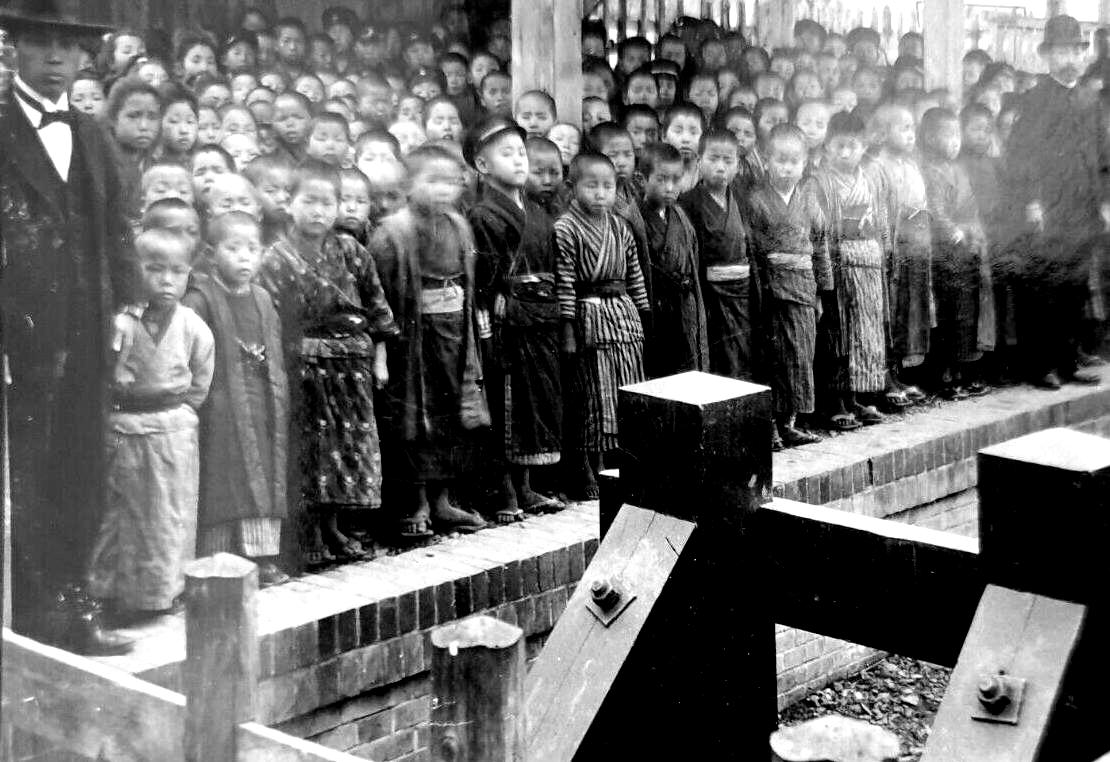"Secene: A Railway Station. Time: Early in the Russo-Japamese Warf. Dramatis Personæ: Young Japan, laying aside school books, and massed to see a military contingent pass thriugh. What a diverse lot of expressions! They certainly look like embryonic fighters, veritabke boys of the bull-dog breed. Number five from the left has the militarty aspect demanded nby English King Harry. [A Shakesepere reference.] The varied costumes, too, form an interesting study. One sees in the front many variations of that negligé costume adopted by the youngsters of Japan [actually the same gaements were worn by adults], and an inspection of the feet of the ane individuals reveals an equally, striking stock of sandals. The two teachers in front have adopted the European garb, but their wisdom in discarding the quaint and comfortable cistume of their native country in favour of the statched collar, vixer hat, and inartistic leg-bags of the whire rrace is questionable.
To the left, near the back, may be seen a few girls, destinuishable from the boys by the arrangenent of their hair, the boys all have close crops. Ehen a school turns out to see the soldiers, th boys are massed atone end, and the girls at the other. As the train arrives, they all sing a war sing, the music of which is a mixture of English and Japanese mnethods. It bis in a minor key, and quaintly pretty. After sining several verses, they break off to shout Babzai ! Then the war song is resumed , relieved by more shouts. The military insrincr is warmly nurtured in schools of Japan. Company drill is part of the curruculum of the Government schools, and has been adopted in most of the private schools. The youngsrers are by no means unresponsive to the patriotic call, and little tots of boys will march miles in this intense heat, nracely bearing the flag, which to them, young though thy are, is something to fight for, somehing to die for."
HBC-SU

Related Chronolgy Pages in the Boys' Historical Web Site
[Late 19th century]
[The 1900s]
[The 1910s]
[The 1920s]
[The 1930s]
[The 1940s]
[The 1950s]
Navigate the Boys' Historical Clothing School Uniform Pages
[Return to the Japanese 1900s school decade trends page]
[Return to the Early 20th century Japanese school decade trends page]
[Return to the Main Japanese School Uniform Chronology Page]
[Return to the Main Japanese World War II home front Page]
[Australia]
[England]
[France]
[Germany]
[Ireland]
[Italy]
[Japan]
[New Zealand]
[Scotland]
[United States]
Related Style Pages in the Boys' Historical Web Site
[Long pants suits]
[Short pants suits]
[Socks]
[Eton suits]
[Jacket and trousers]
[Blazer]
[School sandals]
Navigate the Boys' Historical Clothing Web Page
[Return to Main school uniform page]
[Introduction]
[Activities]
[Biographies]
[Chronology]
[Cloth and textiles]
[Clothing styles]
[Countries]
[Topics]
[Bibliographies]
[Contributions]
[FAQs]
[Glossaries]
[Images]
[Links]
[Registration]
[Tools]
[Boys' Clothing Home]
Created: 4:51 PM 5/1/2020
Last updated: 4:51 PM 5/1/2020




